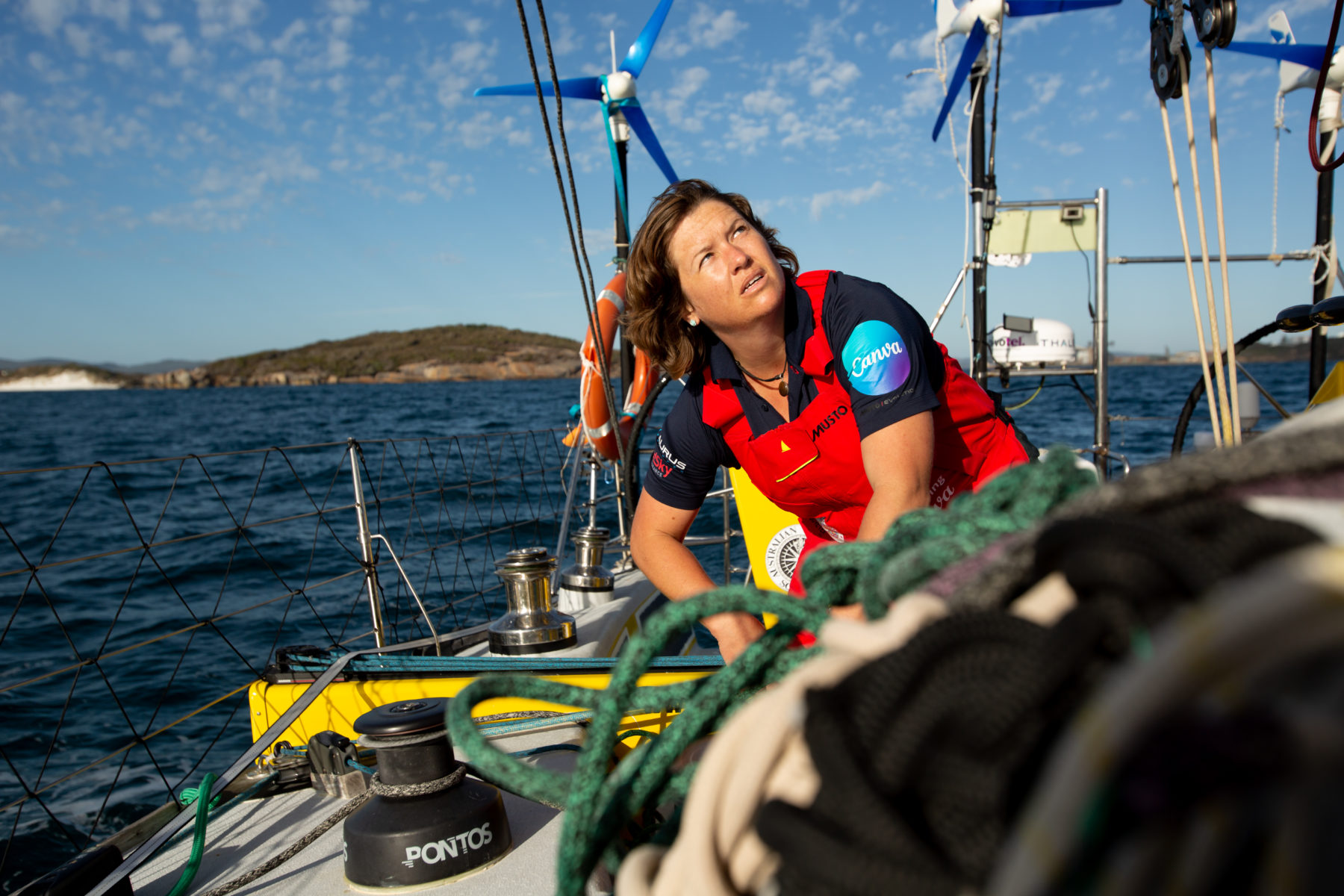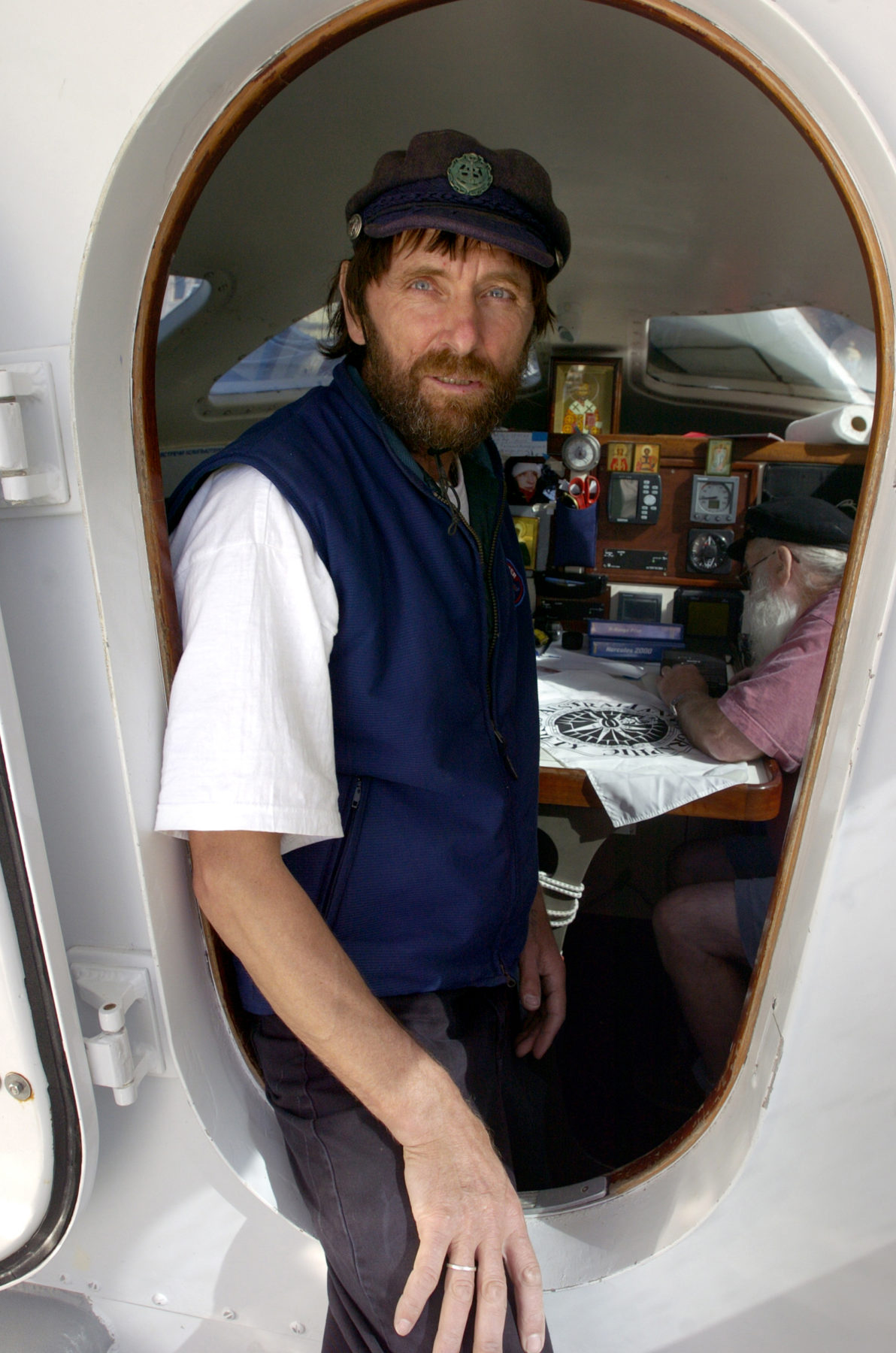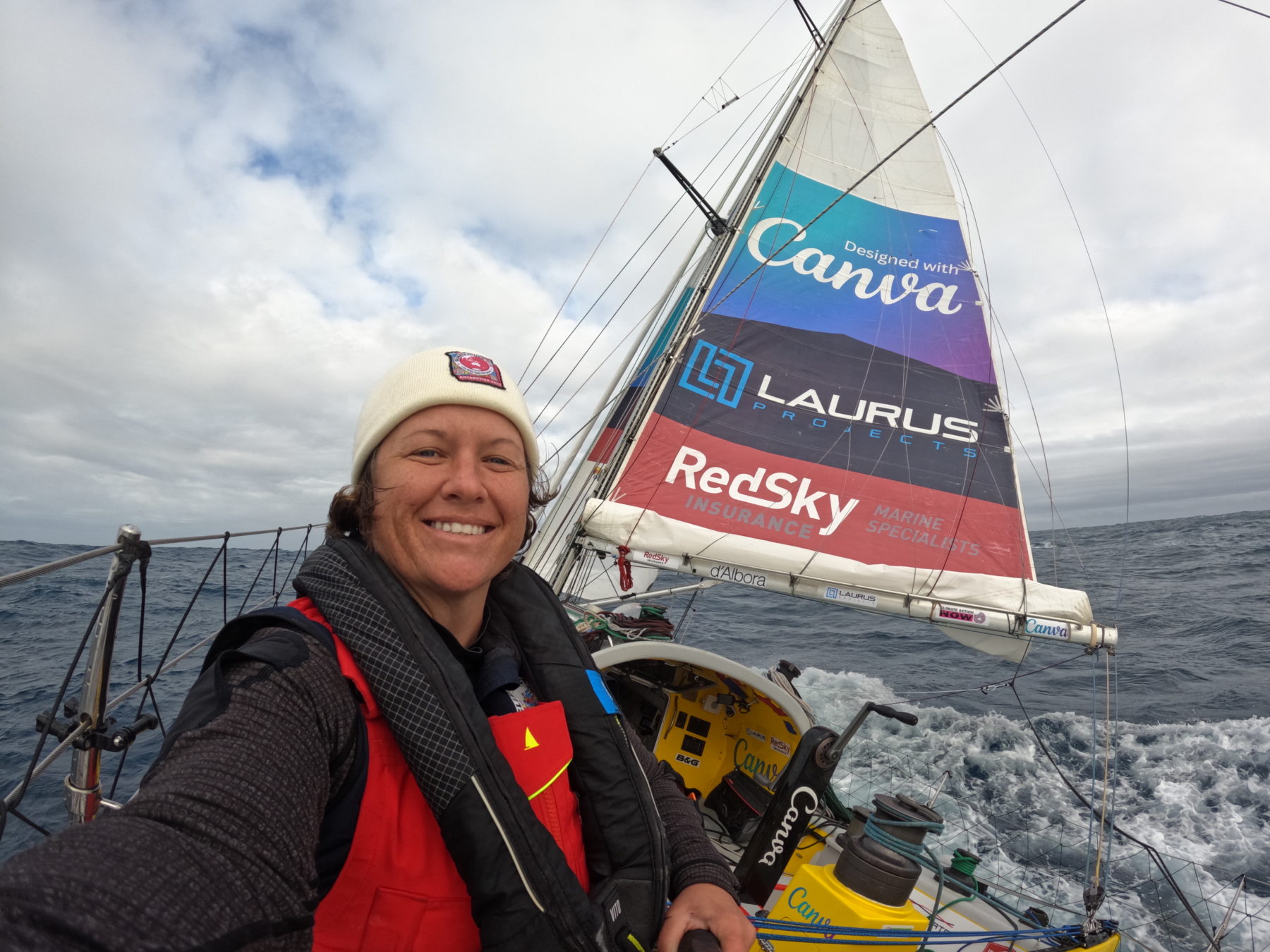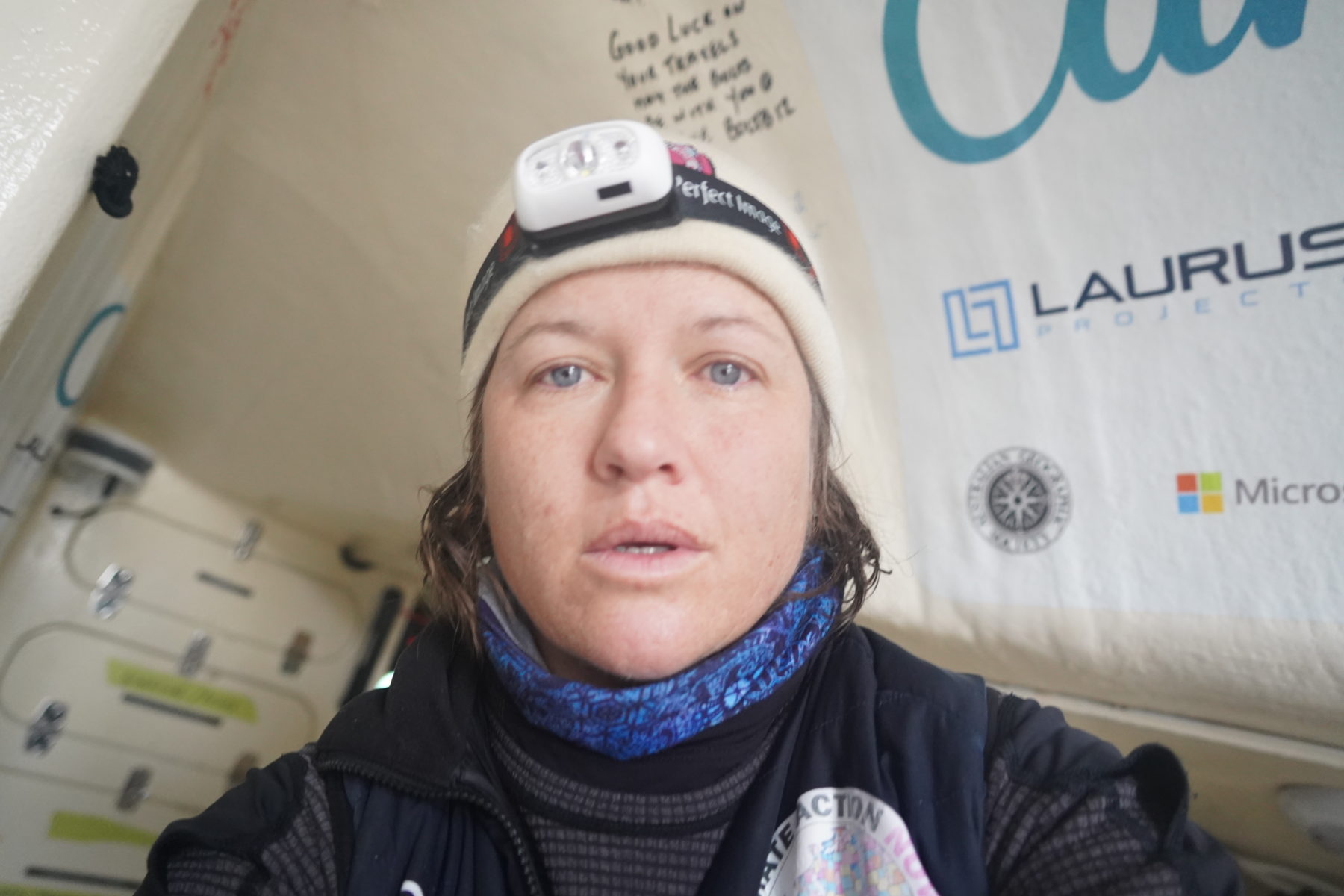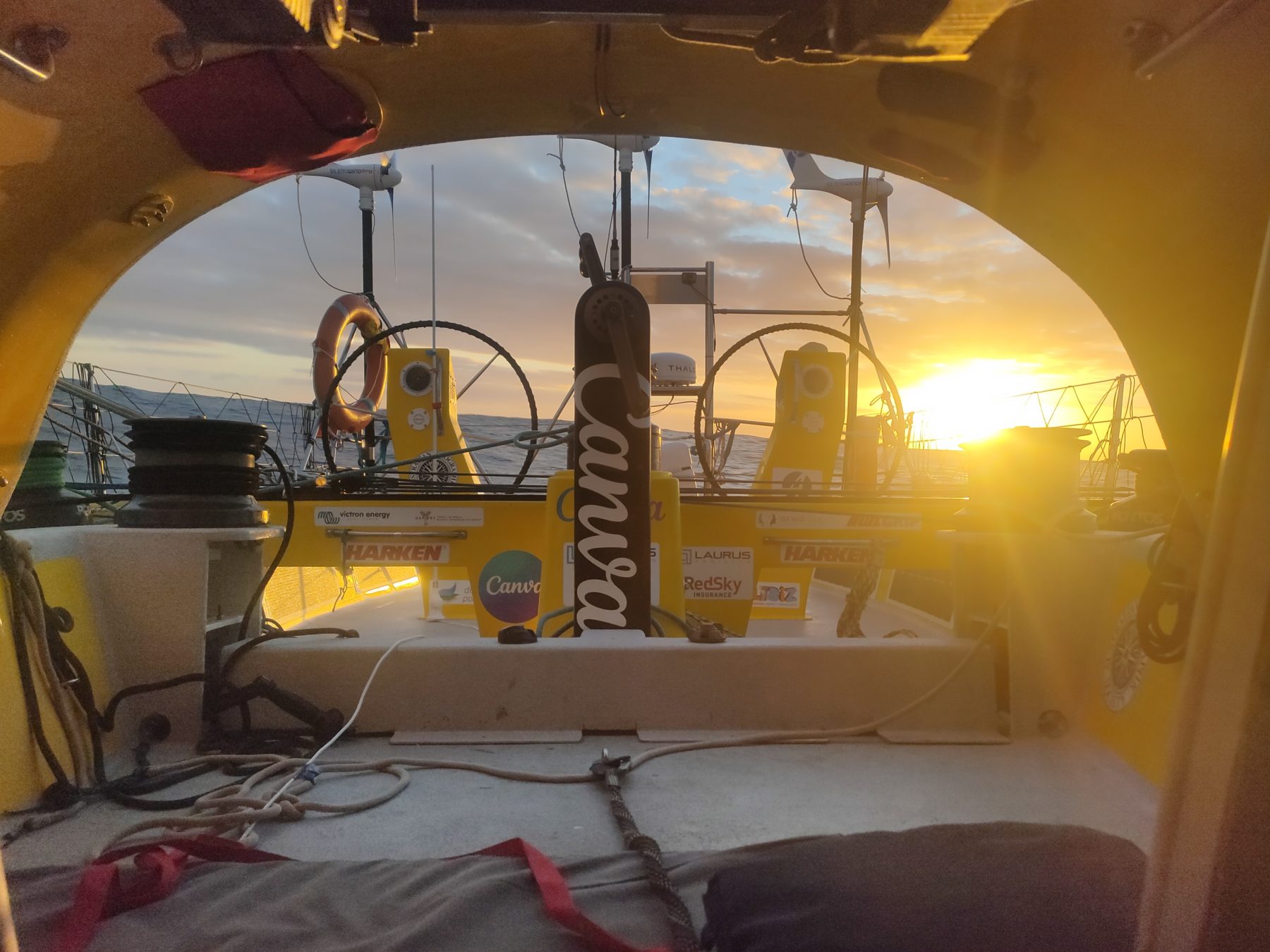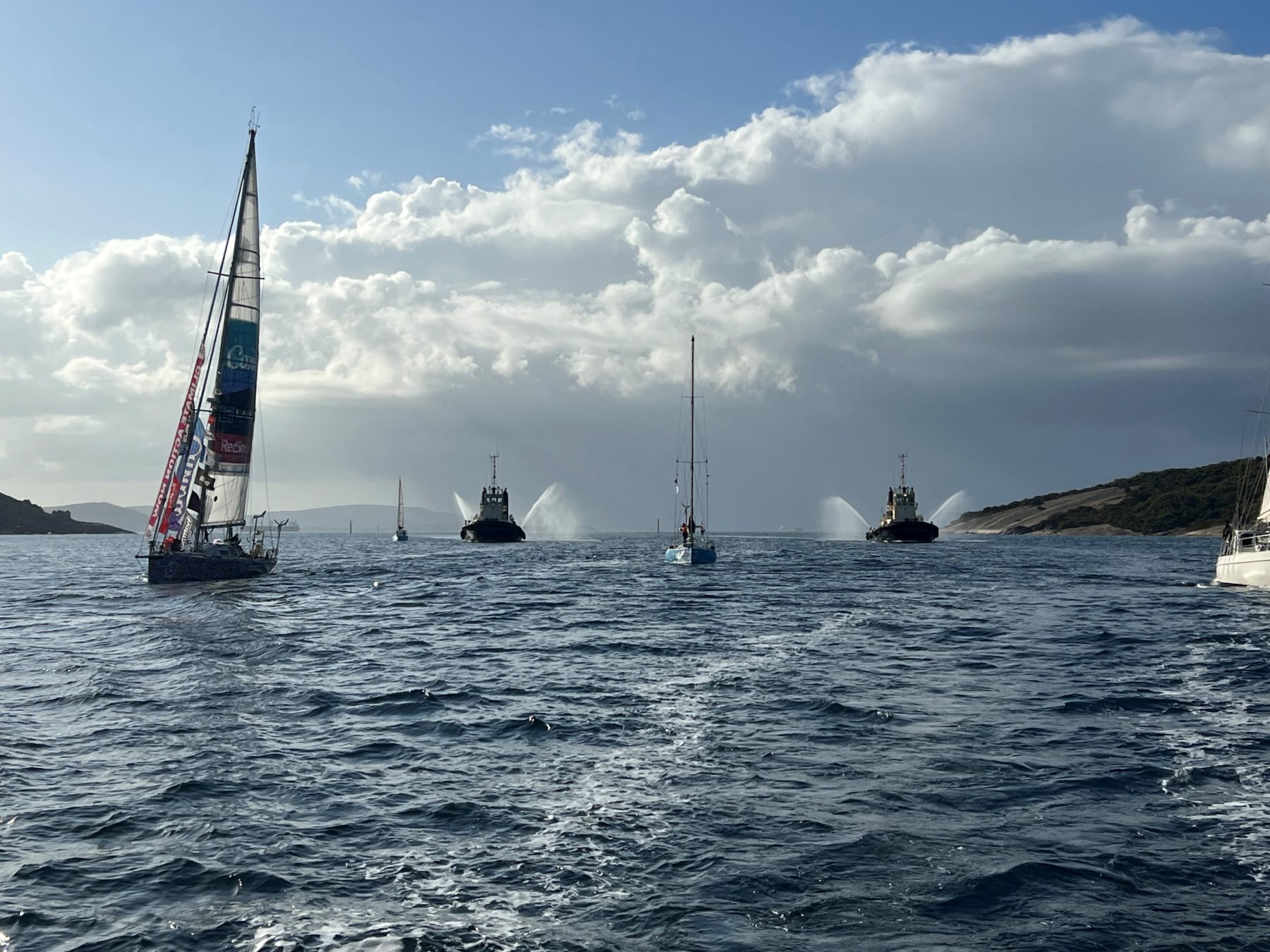The enchantingly raw nature of the Southern Ocean has challenged sailors for generations. Subjected to unrelenting storms and filled by waves of liquid mountains, you sail through testing waters containing snow and ice, and latitudes with names like the roaring forties, furious fifties and screaming sixties. It’s a place where not many sailors have dared to journey, and scarcely any challenge these waters alone. It’s the ultimate endurance test for any sailor and there are few who have the strength and determination to succeed on these waters. And yet it’s a place that calls to my heart.
I never really knew what that would mean for me. And I never understood the power of fear or the after-effects of a traumatic event until I was forced to survive one in the Southern Ocean, 1000 nautical miles (nm) (1852km) from land, alone, and in a storm the size of a cyclone. It was 2017 and I was sailing my 50-foot yacht Climate Action Now solo around Antarctica, attempting to become the first woman ever to complete the trip below 45°S. I was also sailing with the secondary goal of breaking the established record of 102 days, set by Russian sailor Fedor Konyukhov. Three-quarters of the way around Antarctica, on Day 72, in storm conditions, my 22m-long mast came crashing down at sunset. One of the stays had broken due to an unknown electrolysis issue, causing me to dismast.
The mast was violently pushed and shoved by waves the size of a two-storey building, and 45-knot (83km/h) winds were blinding me. The aggressive motion caused the mast to begin sawing the boat in half; time was running out and rescue wasn’t an option. Hypothermia set in as I struggled on the pitching, rolling deck to free the rigging. Soon I was questioning if I’d survive the next five minutes, let alone the night.
It was four hours until I managed to get the boat safe enough to ride out the storm. The next day I diverted to South Africa’s Cape Town. Two months later I restarted my record before finally sailing back to Australia to be acknowledged as the first woman to sail solo around Antarctica with one stop. The experience had a lasting effect on my sailing. It changed my relationship with my boat and the sea and I spent years working to overcome it.
Five years later I finally felt ready to take on the Southern Ocean again. But to give myself the best chance of success and peace of mind at sea, I needed to know Climate Action Now was prepared to the highest level. This meant a six-month refit during COVID, working with shipwrights, stripping everything from the boat and inspecting and repairing sections of the hull before rebuilding.
For the past eight years, I’ve been collecting Post-it Notes from the community. Each describes an environmental action on something their writers are already doing to make a better future. They contain messages such as “Sally has short showers” or “Bob picks up rubbish off the beach”. These are transformed into a digital design, so my whole yacht is then wrapped in thousands of community actions. The campaign’s goal is to inspire: “As individuals, we all have the power to create change. It just starts with one action.”
Adding to this, I partnered with several scientific groups, planning to undertake oceanic research around Antarctica. I committed to gathering 24/7 ocean-water readings on features such as salinity, dissolved CO₂, chlorophyll, and bio-optics. I planned to collect microplastic samples, and meteorological data to assist with global weather modelling by deploying drifter buoys to take barometric readings and measurements of temperature, wind strength and direction, air pressure and humidity. By logging depths, I’d also assist with sea-floor mapping.
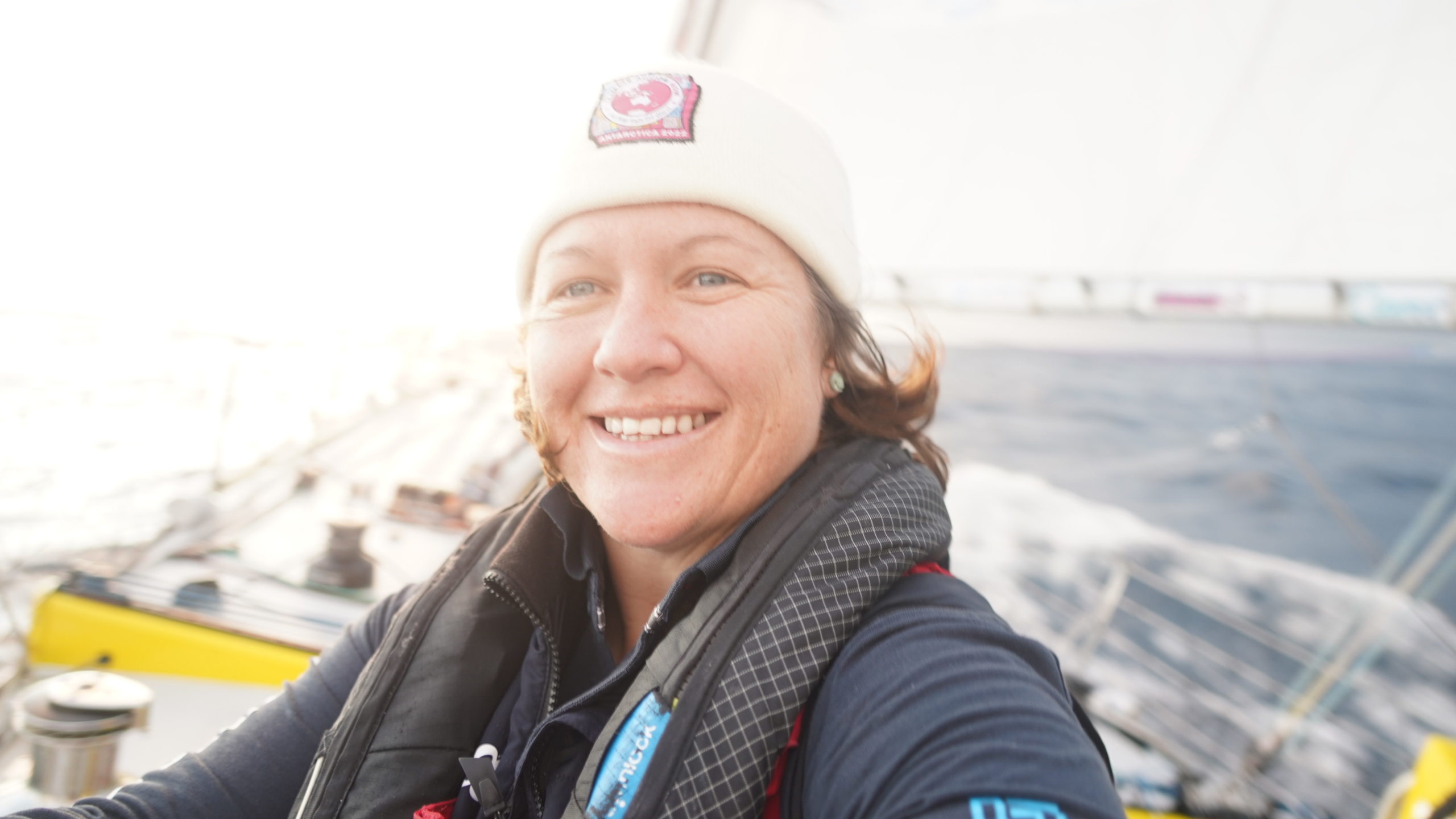
Finally, on 21 February 2022, it was time to depart. I was filled with mixed emotions; one part of me was ready to get going, but the other side was wondering if I’d make it home again. And all the while I knew I’d be leaving anyway. The record started out of Princess Royal Harbour, Albany, in Western Australia with a lively 30-knot (55km/h) easterly wind building up a short choppy swell, making the sailing uncomfortable. I was just excited to be finally leaving again and felt strong, both mentally and physically. Now I just had the short task of sailing solo around Antarctica.
I had to sail to a waypoint at 45°S to enter the “racetrack” before I could turn left and aim for Tasmania. Mild wind conditions made this section of the voyage extremely frustrating. For a solo sailor, it’s more exhausting to sail in light winds than through storms. The autopilot struggles to hold course, so you end up on deck, hand-steering and changing sails as winds swing around you. It becomes exhausting. Added to that, I was behind Fedor Konyukhov’s record.
I crossed onto the official racetrack on Day 6 and started sailing east, across the Southern Ocean. I was getting regular storms, although nothing too dramatic at this point.
On Day 28 I finally took the lead from Fedor. Now all I needed to do was maintain my speed at a fraction faster than his record for the rest of the voyage and I’d finish in front.
On Day 32, after being at sea for just over a month, I sailed through a place called Point Nemo, otherwise known as the Oceanic Pole of Inaccessibility. This is a virtual waypoint in the ocean that marks the furthest place from land anywhere in the world. It’s the most remote location in the ocean. When passing through here I was 1500 nautical miles (nm) from the nearest piece of land, the uninhabited Ducie Island – one of the Pitcairn group. I was nearer to astronauts on the International Space Station than to any human on Earth.
Shortly after, I faced my first truly extreme conditions on this voyage. The weather patterns turned and I was slammed by four major storms, each one the size of a cyclone or hurricane, together spanning more than 1000nm – across the whole of my racetrack. With no place to hide I had no options but to go through the middle and hope we – Climate Action Now and I – were strong enough to come out the other side.
The third storm was the worst. My storm sails were up and I was inside the boat where I’m less vulnerable to injury. I was sitting in my navigation area, which is the boat’s smallest area. I could hear the wind roaring. The waves were forecast to build past 8m in height. Imagine a two-storey building as a wave.
We took several knockdowns where Climate Action Now was slammed by a wave so aggressively that the mast had gone into the water as we flipped on our side. Then, just as I was finishing dinner, the real storm hit. The sound of the wind began exploding around me at deafening levels and I was bracing for things to get much worse.
I soon felt Climate Action Now being lifted by an enormous wave. Up we went, and just as we were reaching the wave’s crest it broke. Metres of white water slammed into the hull, like a freight train, and threw us sideways to the trough. We lay wallowing on our side, as the rest of the wave caught up to and started to roll us.
Bracing inside, with my heart racing, we were flipped almost completely upside down before we started to right again. A quick glance around revealed the cabin had been destroyed and anything not tied down was now in a heap. I scrambled up to check I still had a mast standing and stood shaking while I waited for the adrenaline to pass before starting to clean up. That night we were struck twice more. The violence of these knockdowns is so great you never quite know if the mast will survive. Finally, the storms broke just in time for me to sail around Cape Horn.
These storms travel across the oceans right around the world while gaining strength; Cape Horn is the only place they reach land. At the very bottom of South America, it’s considered one of the most dangerous sections of coast to sail around – the Everest of sailing challenges.
To sail solo around Cape Horn is a huge achievement and I was lucky to make a safe rounding when conditions were gale strength but manageable. That was a day of milestones: I saw land for the first time in 45 days and also my first ship in that time, as well as safely rounding Cape Horn. But the really good news was that I was more than 500nm ahead of Fedor at that stage.
With Cape Horn behind me, I began sailing across the South Atlantic Ocean. My next challenge was to pass Iceberg Alley, around South Georgia and the South Sandwich Islands. There, the polar convergence line, where warm tropical waters meet cold Antarctic waters, pushes further north creating an increase in icebergs. Remember,
I’m on a fibreglass boat. To safely sail through the area, I was receiving satellite readings that would allow me to set exclusion zones around any known icebergs and then I would use a combination of radar and my sea temperature alarm to spot anything else.
It wasn’t a perfect system and I ended up spending several days sleeping at my navigation table for 10-minute intervals so I could check the radar for ice. But I was able to safely sail through despite dense fog.
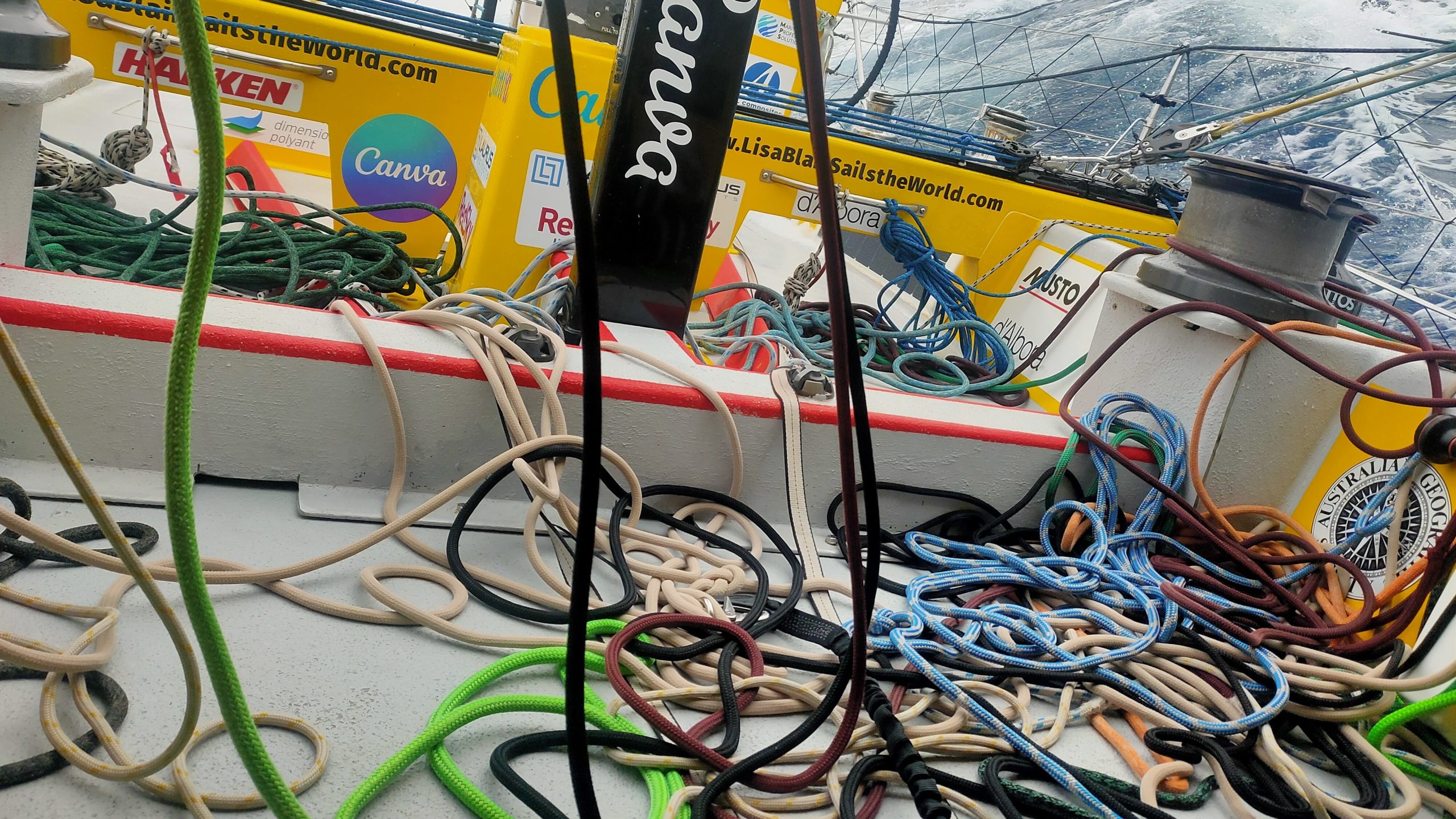
The South Atlantic was basically one big storm with conditions generating lots of squalls – small low-pressure systems creating intense winds for a short time before dumping rain. Average wind speeds were 30 knots (55km/h) so my sails were set for this.
When a squall hit, I’d have to race on deck and shorten the sails to match the 50-knot (92km/h) wind bursts. At those times the ocean would turn into a boiling mess of wind and sea spray before dumping snow, sleet and hail. My hands would be in agony, burning from the cold, but in 30 minutes the squall would pass and I’d then need to go on deck to increase my sail area again.
It was exhausting. The snowstorms and squalls continued for more than two weeks, adding to my fatigue. I was also starting to see an increase in repairs needed with the toll of sailing around Antarctica showing on the boat.
Add extreme sleep deprivation to this, plus the fact I was about to sail back through the place where I demasted last time, and I was reaching breaking point.
On Day 62 it all came crashing down around me as I entered a new storm system. My body wasn’t coping with the conditions, and I was struggling to get warm. I’d been shivering uncontrollably for hours in my bunk and only managed two hours of sleep in 50.
After weeks of minimal sleep, I broke. Nothing was particularly wrong, but I became a sobbing mess, crying in a heap on the floor and couldn’t seem to control it. I clearly needed rest, so after making porridge and changing over the microplastic sample I went to bed to try to get some. But 20 minutes later we were slammed by a 12m wave – that’s the height of a five-storey building. Climate Action Now was flipped upside down and I was thrown into the bunk above me.
So much water was engulfing us that my ears popped from the pressure. Heart in mouth, I waited for the sound of my mast snapping to reach me but somehow it held.
When we righted, I got out of my bunk and noticed the wave had ripped out my washboard and flooded the boat with 20 buckets of water. My batteries were almost completely flooded so I madly started to bail. Then we were struck by a second wave and again by a third. I abandoned my bailing to get on deck and make the boat safer. The forecast was for 6m waves but I was getting a bad cross swell generating double that.
With my life jacket on and tethered to the boat, I went on deck and was eventually able to manoeuvre the boat into the hove to position, a survival tactic that stalls the sails out to allow for a sideways drift.
My breath stalled too, in my chest, as I looked at the ocean raging around me. I was no longer looking across the tops of the waves: instead, I needed to crane my neck back to look up at this skyscraper of water bearing down on me.
Thankfully, I was able to make it through this storm with little damage and finish sailing across the South Indian Ocean. Every few days, I continued sailing through stormy conditions, and with every slam of Climate Action Now I’d tense up.
Because of last time, I never really let myself believe I could do this. So this time it wasn’t until I actually crossed my outgoing track below 45°S that I truly started to believe I was going to set this new record.
On 25 May 2022, with a rainbow overhead and a beautiful new day dawning, we finally sailed across the finish line and into Albany, making me the fastest person ever to sail solo, non-stop and unassisted around Antarctica, crossing all tracks below 45°S. I’d sailed more than 16,500nm (30,500km) across the world’s most dangerous oceans in a record 92 days, 18 hours, 21 minutes and 20 seconds, shaving almost 10 days off Fedor’s time. I collected more than 180 microplastic samples, deployed eight autonomous weather drifter buoys and one Argo research float and gathered 24/7 ocean health data.
Just as importantly, I sailed Climate Action Now’s message to the world.


